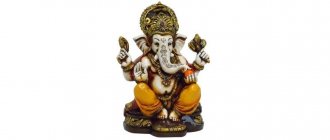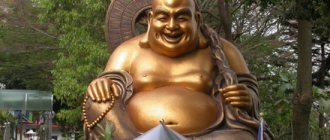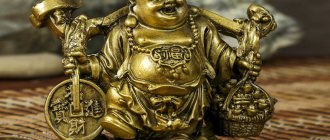The presence of Buddha brings calm and peaceful energy into the home. If your lifestyle cannot be called measured, then you should pay attention to creating a calming environment at home. An active, active lifestyle is a manifestation of yang energy, which must be dissolved with the help of pacifying yin energy. And what could be more peaceful than the contemplative energy of the Buddha?
Calm energy in your home will create a sense of balance, as the quiet yin energy complements and balances the yang energy of an active lifestyle. Why do you need a balance of yin and yang at home and in life? It is required to enjoy excellent health and well-being.
Buddha at home is balance, calm and peace. To decorate the interior, you can use various images of Buddha, from statues to paintings.
Rituals for the talisman
In order for you to achieve all your plans, there are two main rituals performed with the amulet. To perform the first ritual, you should stroke the deity's belly clockwise 300 times. In this case, you need to concentrate and think about your desire all the time. Negative thoughts and negative emotions should not be allowed; there should only be good feelings and thoughts.
When communicating with the amulet, it is better to remain alone with the deity, not to be distracted, especially not to swear or scream. The second ritual is that when leaving the house, it is useful to stroke the fetish on the stomach every time. This will attract good luck and it will accompany you throughout the day.
From the material in the article it is clear that a talisman acquired by any person can radically and qualitatively change his life and the lives of people close to him for the better. The amulet will help many: scientists, entrepreneurs, people in need of housing, families who do not have but passionately desire to have children.
When purchasing a figurine, you need to think through your further actions down to the smallest detail. This means choosing the right place to place the figurine in your home, activating the amulet with pleasure with the participation of all family members, and clearly carrying out all rituals in relation to the fetish.
And then the Hotei figurine will reward you with its favor, will be happy to help you and attract the desired benefits - wealth, happiness, good luck, health!
Legends about Hotei
The prototype of Hotei was a real person named Qi-Tsi. He lived in China and was a monk, traveled around the world and always gave people joy. Many claimed that after he left a certain city, the place was transformed and people became rich. After the death of Tsi-Tsi, craftsmen began to make his figurines for good luck. They were often made of stone and wood.
There is another legend about the origin of the god Hotei. Legend says that Maitreya acted as the Laughing Buddha. He was a wonderful man and the ladies always liked him. After a while, he got tired of being handsome and breaking women's hearts. Maitreya reincarnated as a fat and inconspicuous man, and so that the ladies would not grieve, he gave them happiness and wealth.
There is another version about who Hotei is. It is believed that he was an ordinary preacher who began to laugh after achieving enlightenment. He went traveling with a bag on his shoulder, and instead of preaching, he laughed. People were filled with happiness and also began to laugh. Therefore, Hotei became a symbol of fun, joy, prosperity and relief from worries.
Where to place a figurine in a house according to Feng Shui
Where should the god of wealth Hotei be placed in the house? As with the appearance of the figurine, it all depends on the purpose:
A person who strives for prosperity should place a wisher in the south-eastern part of his office. If there is no office, the bedroom can play its role.
Dreaming of family happiness, a precisely selected Hotei should be seated opposite your bed.
When trying to possess wealth, the talisman is left not far from the jewelry box.
To gain honor and respect from others, the god can be placed facing the front door.
If there are few or no children in the family, it is necessary to leave the god Hotei in the wisdom zone - according to Feng Shui, the northeastern part of the room. By itself, the energy of this zone is conducive to making important decisions, self-improvement and spiritual development, and, supplemented by a god, it will be responsible for family fertility.
Who is Hotei?
Hotei (other spellings: Hotei, Hottei, less often - Budai or Bodai) is one of the most respected Japanese gods, which explains his popularity among Feng Shui adherents. Associated with the deity of entertainment and fun, he is considered the patron of non-labor-intensive work, which is nevertheless capable of generating a good income. His unique nickname is the Laughing Buddha, which was given to Hotei for his light, cheerful disposition.
The name of the god Hotei is translated from Japanese as “linen bag.” The god also had a real prototype - the monk Qitsi, who lived in the 10th century and was Chinese by birth. He preferred idleness and fun to deep spiritual quests, which is why he was a regular visitor to crowded fairs, where he predicted the weather and earned his living from it. The monk's nickname - Budai - came from the name of the alms bag, which was his only property. Symbolically, the second bag, due to its enormous size, was also nicknamed Budai’s stomach, in which, according to Chinese beliefs, vital energy, or qi, was concentrated. According to a legend that soon developed, in the places that Budai visited, people began to attract health, happiness and prosperity.
It is for this reason that already in the 15th century, Budai, or Hotei, began to be considered one of the seven gods of happiness in Shintoism, representing the embodiment of serenity and fun.
Another legend says that Budai was not a monk at all, but a turning point occurred in his life that forced him to turn from a handsome, slender young man into an unattractive and fat man. All because one day the feeling of guilt for the broken hearts of the girls took over in the soul of the young man. Being kind and sympathetic, he deprived himself of external attractiveness and vowed to always give people only wealth and happiness in order to atone for his sins.
What does Hotei bring to people?
To this day, God Hotei gives people decent money, helps them achieve success in their careers with minimal effort, and warns against bad decisions and subsequent problems. In his role as the god of abundance, he is also responsible for open respect from others.
It is believed that in general the god Hotei can fulfill any wish of his owner: for this, his figurine, called netsuke, must be located in the house in the right place according to the rules of Feng Shui. To be sure, it is customary to rub this miniature sculpture on the stomach, thinking about what you want. Read more about the rituals below.
How is it portrayed?
Traditionally, the god Hotei is depicted holding in his hands what the owner of the figurine strives for, be it: children, gold bars, money, coins, bags filled with jewelry, etc. He can also hold a donated horse, symbolizing the owner’s luck.
Blessing
Can sit or stand. With his right hand, the Buddha makes the varada mudra gesture; if standing, he holds the edge of the monastic robe. This image demonstrates the altruistic qualities of the Buddha and does not have any specific stories associated with it.
Buddha in royal attire
In this image, the Buddha is adorned with royal attributes (including a crown) and jewels.
The image has several options. First, the Buddha can stand with both hands making the abhaya mudra gesture, or only the right hand can be raised in abhaya mudra and the left hand can hang freely below. Secondly, the Buddha can sit in any of the above positions. One way or another, the main feature of this image is the royal outfit of the Buddha.
The story associated with the image tells how the Buddha was summoned by his patron King Bimbisara when he was threatened by King Jamburati of a neighboring kingdom. The Enlightened One was in the bamboo forest and watched the invasion of the kingdom of Bimbisara, and then revealed himself in full royal regalia to King Jamburati and demonstrated beneficent powers so that he became his faithful disciple and never again laid claim to the territory of King Bimbisara.
This image of Buddha spread at the end of the 16th century, when the decorative and ornamental art of Ayutthaya reached its peak. It would seem that both the religious and artistic value of the image should suffer from the excessive colorfulness of the outfit. Most likely, this was done in order to decorate and soften the strict stereotyped physique of the Buddha figure. The sophistication, complexity, beauty of design and skill of execution cannot be denied, but the numerous precious stones adorning the image from head to toe are perhaps unnecessary.
However, the use of royal regalia to emphasize the divine origin of characters and enhance the impression is also found in other cultural religious traditions, including Catholicism, Greek and Russian Orthodoxy.
In the original version, the royal attributes were limited to the crown on the head, but eventually covered the entire body of the Buddha. Moreover, the outfit is depicted in two versions: either a monastic robe covered with jewels, or a full-fledged prince’s outfit. The latest version features some of Thailand's most famous Buddha images. Among them, for example, is the so-called Emerald Buddha at Wat Phra Kaew in Bangkok.
Buddha eating from an alms bowl
Buddha has just ordained the son of a rich man and is now calmly eating rice from his alms pot (baht).
Buddha eating rice pudding from an alms pot
The Buddha's left hand holds a ball of rice pudding, and his right hand rests on the pot. The rice was divided into forty-nine portions to last for seven weeks.
Buddha on Banaspati
Buddha stands on the head of Brahma, who in turn kneels on Banaspati's back.
In sad thoughts
Buddha stands with his arms crossed on his stomach (left below, right above). Under the Bodhi tree, the Buddha is busy pondering his achievements in perfect knowledge. Mara tempted him to immediately enter Nirvana, but Buddha refused, wanting to convey true knowledge to the whole world.
Taking the Dead Man's Shroud
Buddha removed the shroud from the rotting corpse, shook off the worms from it, washed it in the river and thus received clothes for himself.
Entering Nirvana
Buddha died when he was eighty years old and entered Nirvana.
Giver of forgiveness
Buddha forgives a person who comes to him and realizes the wrongness of his actions. There are many variations of this pose, among them, for example, the Buddha stands with both palms turned outward, or raising one hand (sometimes left, sometimes right) with the palm turned outward.
Giver of the first law
Making a footprint
Buddha makes an imprint of his right foot. Its symbolic meaning is the movement and spread of Dharma throughout the world.
Demonstration of miracles to the Sakri family
The elders of the Sakri family did not show respect to the Buddha when they entered his father's palace, and the Buddha showed them his power: among other things, he caused heavy rain, which wet only those who did not show him respect, and those who treated him with respect , left dry.
Holding a begging bowl
The Buddha stands upright and holds the alms bowl with both hands at the level of his stomach.
This pose refers to the first morning in Kapilavastu after visiting the palace of Buddha's father. Buddha's relatives were ready to receive him at Nigrodharam, but leaving him in the evening, none of them invited him to breakfast. And in the morning Buddha went to the city to beg for alms.
Protected by Mucalinda
A huge snake protects the Buddha, the hood of a seven-headed cobra rises from behind his back and hangs over his head. Buddha himself, being in deep meditation, sits on the coils of a snake, which serve as the basis for the image. In some cases, the Buddha may be depicted completely entangled in the coils of a snake, so that only his head remains visible - the artists’ literal understanding of history led to such an image.
For 42 days, the great snake king Mucalinda guarded and protected the Buddha, immersed in bliss and unaware that a terrible storm was approaching. The huge snake wrapped seven rings around the Enlightened One’s body, and opened the cobra’s hood over his head so that nothing would disturb him. The storm allegedly raged for seven days. This image was widespread in central Thailand, and was also popular among the masters of Khmer and Burmese iconographic art. In India, on the contrary, it was rarely used. The Thai masters of Sukhothai also preferred not to use it from about the 14th century. In Thailand this position is called "Phra Nak Prok".
Walking in meditation
The Buddha walks with his left ankle raised and his palms crossed (left below, right above) on the upper thighs. The Buddha received comprehensive knowledge and thereafter devoted himself to teaching the Dhamra to the suffering and unfortunate people throughout the earth.
Walking or Walking Buddha
The Buddha walks with his right foot slightly raised above the ground, and his left foot standing firmly on the ground, holding his left hand at chest level (giving enlightenment, blessing all beings, dispelling fear), while his right hand hangs gracefully and naturally at this time. The body forms a balanced pose, curved in three places - tribhanga or S-shaped, very popular in Indian sculpture. Buddha is about to give a sermon about his insight. The figure is in a dynamic position, as if frozen in motion, as if in a paused video. This symbolizes the Buddha's care and attention to every action. He knows that he will not be reborn again.
Statement of the Great Truth
Both hands are placed in the Vitarka Mudra position.
Hair touching
In this pose, the Buddha raises his right hand, about to pluck eight hairs from his head to present to the merchants Tapussa and Bhalika as relics. After his enlightenment, Buddha did not eat for forty-nine days, and they offered him rice, and later became his first disciples.
Bathing in the rain
With his right hand, Buddha pours rainwater on himself.
During a drought in Kosala, Sravasti, the people turned to Buddha for help. Seeing rice suffering from lack of water, Buddha asked to wash his robes. On the way to the pond, the heavens opened up and a downpour fell on the ground, under which the Buddha bathed.
Meditation
The Bodhisattva is in a yoga pose: his hands are on his feet, the left palm lies on the right and takes a cup shape. The eyes look at the tip of the nose or are completely closed. Typically, a statue in this position expresses a blissful state. This is one of the most popular poses in Thailand, where it is known as “sharp samadhi.”
This position depicts an important and heroic episode when the Bodhisattva vowed not to rise from his place until he achieved enlightenment and received the highest knowledge. He strives to find the cause of suffering and the possibility of abandoning it, and in the process of searching he becomes a Buddha. Having entered the deepest stage of absorption in thoughts - dhyana, a state of complete calm in which both pain and joy are absent, he achieved complete and final enlightenment.
According to Thai tradition, Buddha in a state of meditation is most suitable for people born on Thursday. They most often become judges, lawyers and teachers.
Meditation in the Diamond Position
The Buddha is in a closed lotus position, with the soles of his feet turned upward, his legs tightly crossed, and his hands resting on his knees.
This pose was especially popular in the north of Thailand, and was depicted in statues found around Chiang Sien.
Instruction of the Five Disciples
Buddha sits in a yoga pose with his hands in a mudra teaching position. There are four position options in total, which differ in the use of hands. Firstly, the Buddha can be depicted with his left hand lying on his knee and his right hand located at chest level in the vitarka position (the thumb is connected to the index, the other fingers are slightly bent and directed outward). Secondly, the Buddha can be depicted in dharmachakra mudra (“turning the wheel of the law”), in the process of delivering his first sermon to five disciples. Thirdly, he can simply sit in a state of meditation. Fourthly, it can be depicted with a raised right hand, which attracts the attention of students and encourages them to come closer.
Having achieved enlightenment, the Buddha left Bodh Gaya and went in search of five ascetics, with whom he spent six years. He shared with them his newfound knowledge in the Dhammachakra Pavattana Sutta. Here he explained to them the "Middle Path", the Four Noble Truths and the doctrine of the Eightfold Path, the basis of all forms of Buddhism. Buddha's friend Kondanna happily accepted this knowledge and then convinced four others - Vappa, Bhuddya, Mahanana and Assaja.
Pondering old age
The Buddha is in a resting position (open lotus position): his hands are placed on his knees, palms down.
During the last year of his life, the Buddha spent the rainy season in Veluvana, a grove on the peak of Rajagriha Vultures, donated by King Bimbisara. By that time he was eighty years old, he was seriously ill, but heroically endured his illness. Moreover, it served as a topic for him to preach about the transience of life. They talked about the old man Anand, who compared his body to a cart that needed to be repaired with the help of belts and bamboo, and insisted on the inevitability of old age and death for all things.
Mother's Training in Tawatimsa Heaven
Combining four alms pots
The guardians of the four directions came to the Buddha and offered alms, each in his own bowler hat. Buddha did not want to show preference to any of them, so he combined all four pots into one.
Stopping Maru
The Bodhisattva is in a yoga pose, his left hand lies on his knee, his right hand is raised, as if to repel the attacks of the three daughters of Mara. This position has two different options. One is sitting, with the left hand on the hem, and the right hand at chest level (as in abhaya mudra), as if forbidding the daughters of Mara to seduce. The second is a meditation position with both hands on the knees.
This image also has two different interpretations. The first corresponds to the Bodhisattva repelling the attack of the daughters of Mara. The second refers to the moment when the Bodhisattva was in bliss under the Banyan tree, and Mara himself tempted him to immediately enter Nirvana. However, the Bodhisattva refused, saying that the time was not yet for this, because people had not yet received the teaching, and the righteous way of life had not yet spread.
Keeping relatives from enmity
The Buddha stands with his right hand in the abhaya mudra position, and his left hand hanging down, lightly touching his clothes.
The image refers to the episode when the Buddha, after an absence of three months, returned from the heavens of Tavatisma and stopped the enmity of the relatives of his father and mother over the ownership of parts of the river that flowed between their possessions. The relatives agreed and peacefully divided the plots and, through the mediation of the Buddha, ended the confrontation.
Stopping Sandalwood Statue
The Buddha stands with his right arm hanging at his side and his left arm raised to stop his sandalwood image from approaching. An impressive image of this pose can be found in Phutthamonton Park in Nakhon Pathom Province. There this gesture is connected with the movement of the person walking. Another sculpture from Ayutthaya, the ancient capital of Siam, is now located in Bangkok, in the eastern viharn of Wat Pho.
This position can accidentally be confused with “Keeping relatives from enmity,” but they are different positions.
According to legend, while the Buddha stayed for three months in the Tavatimsa heaven and preached there for his mother, on the top of Mount Meru, which is located at the center of the universe and where thirty-three gods responsible for the welfare of people live, King Udayana created an image of the Buddha from sandalwood and placed it in the large hall in the Jetavana garden at Shravasti, in the place where the Buddha usually sat. When the real Buddha finally returned, the statue miraculously came to life and greeted him. However, the Buddha stopped the wooden image with his left hand and ordered it to return to its place in order to serve as a model for future statues that would be made after his death.
Resting or Sleeping Buddha
The Buddha lies on his right side, with his feet and right arm parallel to each other. His monastic robes traditionally reveal his right shoulder, which in this depiction typically rests on a pillow. In this case, the left arm is parallel to the body, and the left shoulder is closed.
In the Indian tradition, this position of Mahaparinibbana is the end of the Buddha’s life path and entry into nirvana. However, in Thailand after the Sukhothai period it is perceived differently. There, such a position means that the Buddha is simply resting. In addition, again, according to Indian tradition, the image of a figure in a lying position should be the same as in a standing position, only horizontal. This explains the presence of a “flying hem” on the monastic robe, which creates an “unearthly” impression.
Opening the world. Connecting three worlds: Heaven, Earth and Hell
Having descended from Tavatimsa heaven, Buddha performed a miracle: he united the three worlds - Heaven, Hell and Earth, and the inhabitants of each of them were able to see each other.
Vakkali's suspension
The Buddha's left hand rests on his knees, and with his right he makes a gesture of withdrawal.
Brahmin Vakkali was impressed by the appearance of the Buddha, but the Buddha told him that appearance and physical condition should not be given attention, for sooner or later they will fade and decline, instead one should follow the dharma.
First sermon
The Buddha appeared at the Deer Park in Isipatana near Benares, where he preached his first sermon to the Five Disciples.
Commander of the Waters or Stopper of the Ocean
The Buddha stands with both palms raised, as if he is trying to push something away. The pose is similar to “Return from Heaven Tavatimsa” with double vitarka mudra, but they should not be confused.
In Thailand, this pose is called "Stopping the Ocean or Preventing the Rising Waters", but it originates from the flood in Sakharam, which is located on the banks of a river in India.
Buddha appeared at the Cassowary camp, where there were about a thousand fire worshipers, and asked to spend the night. He was settled in a dilapidated house on the river bank, which was often flooded. To prevent this, the Buddha caused the waters to subside and thus showed Cassowary and his followers the true path.
Subduing Maru or the Calling of the Earth as a Witness
Buddha sits in a yoga pose, holding his left hand on his foot, palm facing up. The right hand is placed on the knee and points to the ground, sometimes touching it lightly.
This pose, also known as Calling the Earth as Witness, is most popular in Thailand. Mara and his horde tempted the Bodhisattva: the demons promised him power, wealth and carnal pleasures. However, the Buddha rejected them all with contempt and continued his thoughts. This rejection of Mara symbolizes victory over oneself.
Pointing to a corpse
Buddha delayed the cremation of the corpse for three days; he wanted people to look at it and think about the transience of life and the temporary nature of their stay in this world.
Receiving water
On the way to Kapilavastu, Buddha was overcome by illness. He asked Ananda to bring some water from a nearby river. However, many carts had already crossed the river that day, so the water was incredibly dirty and hardly drinkable. But when Ananda scooped up the water, it turned out to be clean.
Obtaining bundles of grass
One evening after dinner, the Bodhisattva received eight bundles of cut grass from the brahman Sotthiya. On this grass, Buddha was able to sit comfortably under the Bodhi tree in Bodh Gaya.
Ordination of the first student
Upatissa and Colita were ordained to the clergy, receiving the highest rank.
Predictive
Calling the Earth to Witness or the Suppression of Mara in the Crystal Palace
Rain Caller
The Buddha stands, his right hand is located at chest level, in the vitarka mudra position, and seems to call for rain, and his left palm is gathered into a handful, as if asking for an offering, rainwater should be collected in it. In some variations of the position, the Buddha can sit with his legs crossed (the position of his arms is maintained). The style of clothing can be either Kandahar or northwestern Indian: the monastic robe falls in symmetrical waves. The feet are placed naturally, not as formally as is usually the case with other Thai statues of the same time.
This pose gained popularity during the Dvaravati Mon period. The seated version was created by order of King Rama I, and since then this image has been used in the procession of the plowing festival in mid-May. The standing version was introduced by Rama V.
Mango Host
Buddha sits in a yoga position and holds a mango in his right hand, his hand resting on his knee.
When Buddha was in Veluwan, some people demanded that he show them a miracle, thereby proving his power. Then Buddha took a mango fruit and squeezed it into a pot, drank the juice, and planted the seed in the ground, from which a huge tree immediately grew and immediately began to bear fruit abundantly.
Accepting rice treat from Sujat
The Buddha sits in a meditation position with his palms open and turned outward. After the Bodhisattva realized that mortification was not the path to enlightenment, he accepted food from Sujata, thereby ending his extreme asceticism. After that, he left the hermits with whom he had walked this path in Urvel, and he himself went to Bodh Gaya.
Taking the Ink Nut
Buddha holds a small ink nut in his right hand.
In the seventh week after his enlightenment, Buddha sat under the Ket tree. At that moment, Indra offered him an ink nut.
Taming the wild elephant Nalagiri
Buddha stands with his right hand at waist level, palm facing down. A certain ill-wisher sent his elephant Nalagiri to the Buddha so that he would harm him. However, Buddha tamed him.
Threading a needle
The Buddha has both hands in front of his chest and is focused on threading the eye of the needle.
Buddha makes clothes from rags taken from a dead man. By doing this and concentrating on penetration, he receives insight that leads him to understand the last of the Four Noble Truths - the Eightfold Path.
Preacher Angulimala
Angulimala was a bandit and serial killer who had to pay his mentor a debt - a thousand fingers of his right hand. To pay off this debt, he killed innocent people, cut off their fingers and made a garland out of them. But one day in the forest he met a lonely Buddha. The killer took out his sword and ran after him, but despite the fact that the Buddha walked slowly, Angulimala could not catch up with him. When the robber began to lose his strength, he shouted to the Buddha to stop, but he replied: “I am already standing, Anuglimala, and always have been standing. Because I am merciful to all living things, and you are merciless. That’s why I’m standing, but you’re still not.” After this, Anlugimala threw down his sword and received the Buddha's blessing.
Preaching to Father
Buddha preaching for the last time
On the last day of Buddha's life, Ananda, on his orders, went to the city in order to carry his word to the people. A traveler of another faith named Subhadda came to the Buddha to ask some questions. The Buddha explained to him that it is impossible to achieve enlightenment outside of Buddhism. Subhadda was inspired by his ideas and even decided to become a monk. Although for followers of other religions, as a rule, there is a “probationary period” before entering the priesthood, an exception was made for Subhadda, and he immediately became the last direct disciple of the Buddha.
Farewell to Vesali
Buddha stands, looks over his right shoulder (sometimes over his left), and holds his right hand on his stomach.
After recovering from an illness caused by contaminated pork, the Buddha decides to leave Vesali forever. Knowing that he will never return, he looks at the city for the last time.
Floating an empty alms pot on the water
Having eaten all forty-nine portions into which the Bodhisattva divided the rice, he lets the empty alms pot float down the Neranjara River. If the pot does not sink, but floats against the current, then this is a sign that the Buddha will achieve enlightenment. If the pot floats against the current and does not sink, this will mean that enlightenment is achievable for the Bodhisattva.
Travel by ship
The Buddha is seated, and in the so-called Western position, also known as the European position. The image can have two options. In one hand they rest on their knees, in the other the right hand is at chest level, and its palm is turned outward.
Having achieved enlightenment, Buddha was going to visit his father, but to do this he needed to cross the river.
Omens explained
The right hand of the Buddha is located on the knee, the palm is turned. In this case, the left hand is at chest level, and its palm is turned outward.
The Buddha informed Ananda that he had the power to extend his life if he asked. However, Ananda twice rejected the Buddha's proposal, as he fell under the influence of Mara. Then the Buddha sent Ananda away and made a prediction to him that he would inevitably die and enter Nirvana.
Looking at food in a begging pot
Eight days after the Bodhisattva became a monk, the local ruler gave him food for the first time.
The decision to enter Nirvana
Buddha holds his right hand on his chest.
Buddha is immersed in thoughts about his own old age and the nearness and inevitability of death. He decides to enter Nirvana on the night of the full moon, three months before his death.
Deciding to become a monk
Despite heavy security, Siddhartha leaves the palace for Kapilavastu on horseback, accompanied by his charioteer Chandaka.
Descending from Heaven
Indra created three staircases that connected heaven and earth. One for myself, the second for Buddha, the third for the brahmins.
Standing Buddha
The Buddha's eyes are downcast, he himself stands with his arms hanging along his body.
This pose of the Buddha indicates his complete confidence in his actions.
Solitude in the forest
Buddha was tired of the Kosambi monks, who were divided into two groups and lost harmony, and he preferred solitude in his own forest.
Here the elephant Palilayka drew the attention of him and offered the Buddha a drink of water, while the monkey brought him a beehive with honeycombs.
Pointing to Mara
The Buddha holds his right hand bent at the elbow, with the palm facing outward and the index finger pointing upward. The left arm hangs freely along the body.
The Buddha visited the recently deceased and pointed to Mara, looking around in the clouds in the vain hope of catching the spirit of the deceased.
Mortification of the flesh
A thin and emaciated Buddha sits in a meditation position. For six whole years he practiced extreme asceticism and was on the verge of death from exhaustion. However, he eventually realized that between extreme asceticism and worldly existence there was a “middle path.”
Miracle in Sravasti
Buddha sits in a “European” manner, as if on a chair. The legs are slightly apart, the right hand is located at chest level and folded into the vitarka mudra position (the thumb is connected to the index finger, the rest are slightly bent), the left hand rests on the knee. In this case, the Buddha’s feet rest on the lotus. In addition, in some cases the Buddha may be depicted in a standing position.
The miracle at Sravasti is a manifestation of power before non-believers in order to convince skeptics and representatives of all kinds of religious sects. Buddha showed them his heavenly halo and revealed himself in an exalted form, which was accompanied by storms with thunder and lightning and earthquakes. Buddha also created himself by making a Double Appearance.











